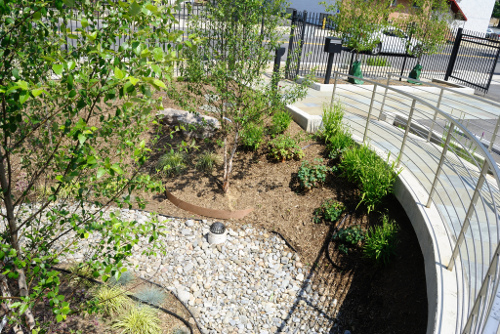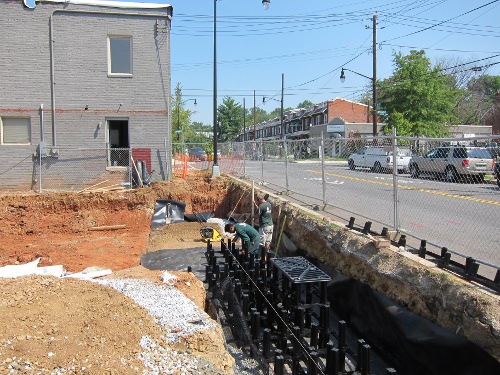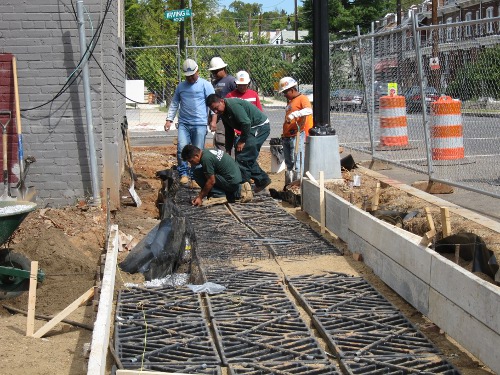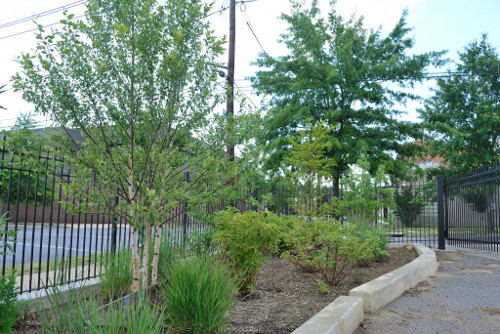
As the year winds down, we’ll be looking back at some of the project case studies we’ve completed in 2011. This one examines the new headquarters of Casey Trees, a renowned non-profit dedicated to the restoration, enhancement, and protection of urban trees, where Silva Cells are helping to manage stormwater on-site in one of the first SITES pilot projects nationwide. You can find the original case study, in addition to all other featured projects, on the Case Studies page of our website. This project was also featured in September’s CE News.
Casey Trees is a Washington D.C.-based non-profit whose mission is to restore, enhance and protect the tree canopy of the nation’s capital. To fulfill this mission, Casey Trees plants trees, engages thousands of volunteers, provides year-round continuing education courses, monitors the city’s tree canopy, develops interactive online tree tools and works with elected officials, developers, community groups to protect and care for existing trees and to encourage them to add new ones.
 When Casey Trees was planning their new permanent Brookland headquarters at 3030 and 3015 12th Street NE in Washington D.C., they wanted to construct a building that respected the character of the historic Brookland neighborhood, highlighted their tree planting and education efforts, and that served as a model for innovative Low Impact Development (LID). In doing so, Casey Trees incorporated several external green
When Casey Trees was planning their new permanent Brookland headquarters at 3030 and 3015 12th Street NE in Washington D.C., they wanted to construct a building that respected the character of the historic Brookland neighborhood, highlighted their tree planting and education efforts, and that served as a model for innovative Low Impact Development (LID). In doing so, Casey Trees incorporated several external green
features that qualified them to be invited to participate in the Sustainable Sites Initiative™ (SITES™) Pilot Program, one of only 150 projects in the United States and abroad to be included.
Still, the SITES designation was only a part of the strategy: “We wanted a truly exemplary project which shows leadership in both arboriculture and hydrology” say Mark Buscaino, Executive Director of Casey Trees. The centerpiece of the project is the incorporation of trees in to their on-site stormwater management.
Like many cities nationwide, Washington D.C. is grappling with the cost of overloaded storm sewers. New regulations in the District require property owners to absorb at least 90 percent of their properties’ rainfall runoff, or 1.2 inches during a 24-hour rainfall. This means that homeowners have to find solutions that prevent 90 percent of storm water from leaving their sites. The requirement for federal buildings, 1.7 inches during a 24-hour rainfall, is even more stringent.
Both the District Department of the Environment (DDOE) and D.C. Water charge for water runoff by calculating impervious surface area on a property. However, property owners may mitigate these charges through green infrastructure solutions that capture and manage stormwater on-site. The Casey Trees headquarters project showcases how keeping stormwater on-site can mitigate these charges while nourishing large urban tree growth.
At ground level, rain water flows from the roof surfaces and parking lot are funneled into a 1,700-square-foot bioretention planter that can handle a 1.2” rain event. A street tree pit that controls stormwater runoff from 12th Street is adjacent to and connected underground with the on-site bioretention garden. The adjacent sidewalk is supported underneath by Silva Cells, which provide six feet of planting soil underneath the hardscape so the street trees’ rooting zone will not be constrained by the planting strip; instead, the roots can penetrate under the sidewalk and into the adjacent onsite bioretention planter.
Casey Trees planted a diverse set of planting including bald cypress, Jefferson American elm, river birch, sycamore and sweet gum in the rain garden and in the retention planters along 12th Street. The system can already manage 5” of water and will become capable of handling even greater quantities as the trees increase in size and can more meaningfully contribute to the performance of the system through interception, evapotranspiration and soil infiltration.
By designing a site with adequate bioretention soil volumes, Casey Trees has created a headquarters that will showcase mature tree growth in a dense urban environment.
The headquarters will also demonstrate to property owners and developers a cost-effective means of reducing their taxes, fees and maintenance costs through green infrastructure.
Installation Summary
Total soil volume per tree: 1,700 ft3 in Silva Cells
Drainage area: 12,970.93 ft2 @88% Impervious=
11,406.09 ft2
Number of trees: 3
Total Silva Cells: 170 frames, 60 decks
Installation date: August 2010
Installation type: Integrated – Trees & Stormwater
Project site: Streetscape
Project designer: Casey Trees
To learn more about this project or others, visit the Silva Cell section of our website, or contact us directly.
Images: first and last from Casey Trees






Leave Your Comment